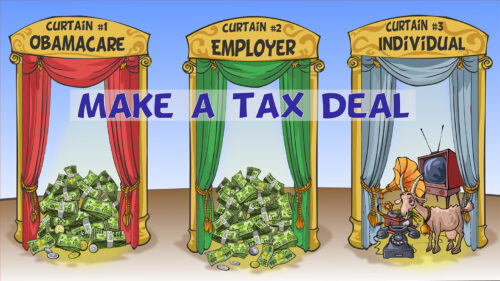Bob buys a health insurance plan through his employer from Blue Cross Blue Shield. The plan has a $1,000 deductible and $5,000 out-of-pocket maximum. Bob is able to pay his portion of the premium on a pretax basis. Not only does he save the income tax; he also saves his FICA taxes on the premium.
Barbara’s employer does not offer health insurance, so she buys a health insurance plan directly from Blue Cross Blue Shield. The plan has a $1,000 deductible and $5,000 out-of-pocket maximum. Barbara pays for her health insurance with after-tax dollars.
Is it fair that Bob uses pretax dollars and Barbara uses posttax dollars for something the federal law requires each person to purchase? This is not a trick question. The obvious and easy answer is that it is not fair. The taxation of health insurance subsidies and premiums is inconsistent and discriminatory. Is that okay?
Largest Tax Expenditure
Before diving into the subject of the taxation of health insurance, it is important to understand a bit of Washington, DC, vocabulary. If I were campaigning for office and said, “I will reduce the federal deficit by reducing tax expenditures,” what would I mean? If you thought I was going to reduce government spending, you would be wrong. Tax expenditures refers to money the federal government allows you to keep that would otherwise be theirs. These expenditures used to be referred to simply as tax deductions. Therefore, “reducing tax expenditures” means reducing deductions and increasing taxes.
Employer-sponsored health insurance is the largest tax expenditure in the Internal Revenue Code. At over $3.6 trillion over the next ten years, it dwarfs other tax expenditures, such as 401(k) deduction, mortgage interest, and state and local taxes. (1) Because employer-sponsored health insurance is the single largest tax expenditure, any government discussion about how to reduce the federal deficit and debt inevitably includes this issue. The tax inequity between employer-sponsored and individual health insurance makes it an even more desirable political target.
Why Don’t Lawmakers Just Change Health Insurance Taxation?
So why don’t lawmakers just make all health insurance an after-tax purchase and pocket the $3.6 trillion? First, voters don’t like tax increases, and this one would hit an estimated 159 million people. It would also whack the workers whose contributions also become posttax, subsequently decreasing their take-home pay through increased taxes. If you said in your campaign that you cared about workers, small businesses, and/or the middle class, implementing this $3.6 trillion pot of gold may feel politically impossible.
Other employee benefits that receive favorable tax treatment have a cap on the deductible amount. For example, 401(k) and similar retirement income plans have caps on how much an employer and an employee can contribute. The employer-provided premium for life insurance above a $50,000 benefit for employees is taxed. In long-term disability insurance, either the premium or the benefit must be taxed. Employer-sponsored health insurance is the only benefit with no cap on either the employer or employee deduction.
Obviously, adding a new tax would be politically unpopular. However, there is another major reason that deficit hawks have avoided this potential windfall: The federal government needs employers to stay in the health insurance financing game. The tax-preferred treatment of health insurance makes it an attractive and efficient compensation element for employers. If employers drop coverage, the demand for government-funded coverage skyrockets, creating other budget problems. A major drop in the offer rate of employer-sponsored health insurance would negatively impact the labor participation rate, which would compress GDP growth. The potential collateral budget damage makes a move on the tax exemption for employer-sponsored health insurance a dangerous game.
If it is too politically sensitive to kill the tax-preferred treatment for employer-sponsored insurance, then why don’t politicians allow individuals the same tax advantage? The simple answer is that tax-preferred treatment for insurance directly increases the federal deficit by further reducing tax revenues. Blatantly increasing the deficit is dangerous in a reelection campaign.
Is No Change Affordable?
Our country is facing a growing deficit and debt. A fiscally responsible look at the annual deficits and growing debt would force a look at the government cost of healthcare and revenue linked to it. The CBO’s “Federal Subsidies for Health Insurance Coverage for People Under Age 65: 2018 to 2028” paints a bleak picture of the federal government’s healthcare financing. The net cost to the federal government after accounting for offsetting revenue is a whopping $9.25 trillion over the next decade. This number does not include the taxes, funding, and expenses for Medicare for people age sixty-five and over, which has its own solvency issues over the same period. It also does not include the states’ portion of Medicaid/CHIP funding, which is approximately another one-third, or $2 trillion, more.
| Net Federal Subsidies Associated with Health | |||
| Insurance Coverage for People Under Age 65: 2019 to 2028 | |||
| Expenses | Revenue | ||
| Work-Related Coverage | $3,725 | ||
| Medicaid/CHIP | $4,034 | ||
| Nongroup Coverage | $760 | ||
| Medicare | $1,049 | ||
| Total | $9,568 | ||
| Cadillac Tax | $47 | ||
| ACA Penalties | $104 | ||
| Health Insurance Tax | $161 | ||
| Total | $312 | ||
| Net Cost | $9,256 | ||
|
$ Billion |
|||
| Source: Congressional Budget Office, “Federal Subsidies for Health Insurance Coverage for People Under Age 65: 2018 to 2028.” Cbo.gov May 2018. | |||
What’s Next?
I don’t like paying taxes any more than the next guy. However, the US federal government’s support of health insurance coverage is fiscally irresponsible. Someday, we must face the truth of our healthcare-financing problem: The question is not if the unlimited tax exemption for employer-sponsored health insurance will be changed, but when, how much, and for whom it will be changed. The easy public target is the wealthy, so I anticipate the dialogue will start with capping the exclusion for individuals above a specified income threshold. That will be a start, but the issue won’t die there.
Next week, I’ll begin diving into “treatment options” for our issues. Tune in to hear what I have to say. And, if you haven’t already, I encourage you to sign up for the “Insiders’ Club” where you’ll be notified when I release new information on my book “The Voter’s Guide to Healthcare: A non-partisan, candid, and relevant look at politics and healthcare in America.”
And great news…the book is also now available for sale on Amazon and Barnes and Noble. Check it out if you’re interested or contact your Holmes Murphy representative!
Source
(1) Congressional Budget Office. “Federal Subsidies for Health Insurance Coverage for People Under Age 65: 2018 to 2028.” Cbo.gov. May 23, 2018.







